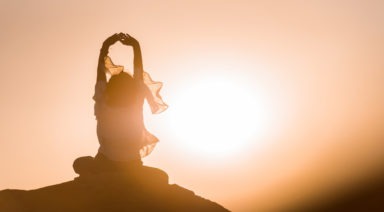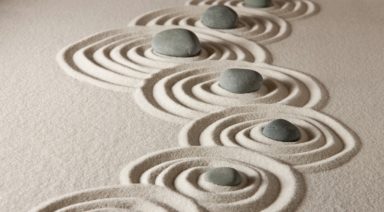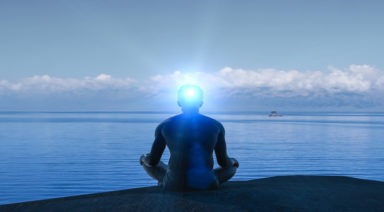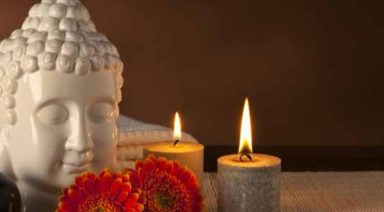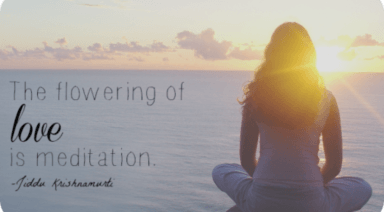How to Harness the Power of the Shri Yantra
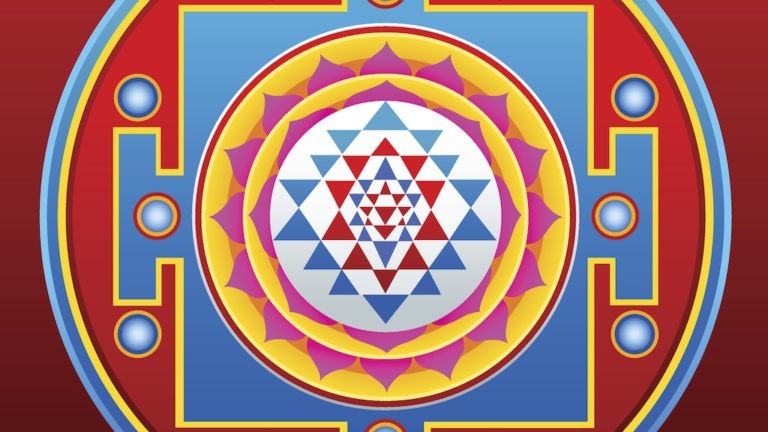
It’s everywhere — on t-shirts, jewelry, coffee cups, and wall decals. The ancient Shri Yantra has become a trendy design, but most don’t realize the complexity, meaning, and symbology of the nine interlocking triangles and double ring of lotus petals. There is little question of the power of an accurately constructed Shri Yantra. In 1987, Russian scientists used EEG technology to prove that the Shri Yantra geometry quickly brings viewers to a meditative state (Source: Biology Faculty of Moscow University, October 30, 1987).
What is a Yantra?
In Sanskrit, the word “yantra” comes from the root word “yam,” which means “instrument” or “support,” and “tra,” derived from “trana,” meaning “release from bondage.” A yantra is an instrument or tool, for meditation and contemplation and supports spiritual liberation. There are hundreds of yantra designs related to deities, principles, and planets. Used in ceremonies and rituals, yantra designs can be found on paper or bark, or created from flower petals, ash, and rice.
For mediation practices or “vastu,” the vedic version of feng shui, a yantra is embossed on a square copper plate electroplated with gold. The plates are then ritually “charged” by priests — meaning that the physical objected is “tuned” to a specific vibration or energy. Once charged, the yantra is viewed as a sacred object.
The Queen of Yantras: The Shri Yantra
The Shri Yantra, called the “queen of yantras,” (rajayantra) is the symbol of the great divine mother principle, the source of all energy, power, and creativity. Vedic traditions, specifically the Shri Vidya school of tantra, regard the design as the representation of the universe as well as the body of the goddess related to the feminine principle of shakti or energy. Every line, triangle, and lotus petal symbolizes a specific type of shakti.
The outer square represents the earth element. In Vedic sacred geometry, the square corresponds to the earth. The outside square represents mundane emotions, such as anger, fear, and worldly desires. The yogi meditates on the outer square to defeat these disturbing energies. The T-shape structures in the square are considered the gates of the four directions, and the entry points of the yantra.
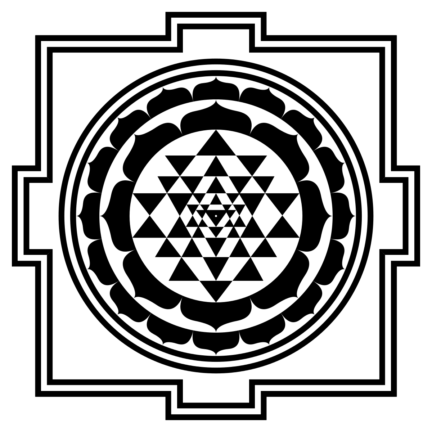
Next are three circles representing the past, present, and future. Within is the first ring of sixteen lotus petals representing complete fulfillment of all hopes and desires. Specifically, the petals represent the ten organs of perception and action (tongue, nose, mouth, skin, eyes, ears, feet, hands, arms, and the reproductive organs), and the five elements: earth, water, fire, air, and space. The sixteenth petal represents the mind, which gathers and interprets information from the perceptions of the interactivity of the elements.
Next is an eight-petal lotus. Each petal governs a specific activity: speech, grasping, motion, excretion, enjoyment, revulsion, attraction, and equanimity. Within the inner lotus is the first set of interlocked triangles. Those that point upward represent the masculine principle, downward represent the feminine. These triangles also represent qualities and Shaktis.
Starting at the lowermost outer triangle and moving in a counterclockwise circle, they are agitation, pursuit, attraction, delight, delusion, immobility, release, control, pleasure, intoxication, an accomplishment of desire, luxury, mantra, and the destruction of duality.
The next circle has the same sequence and direction, starting from the lowest triangle and moving counterclockwise. The first triangle is the giver of all accomplishments. Next is the giver of wealth. The third is the energy of activities that please all. Fourth is the bringer of all blessings. The fifth is the granter of all desires. Next is the remover of all suffering. The seventh is considered the appeaser of death. Eighth is the overcomer of all obstacles. Ninth is the bringer of beauty, and the tenth is the giver of all good fortune.
The ten smaller triangles in the third circle represent, beginning at the same, lowermost triangle and moving counterclockwise: omniscience, omnipotence, sovereignty, knowledge, destruction of all disease, unconditional support, vanquishment of all evils, protection, and the attainment of all desires. The fourth circle of triangles, again starting at the same point and moving counterclockwise, represent: sustaining, creating, dissolution, pleasure, pain, cold, heat, and the ability to choose action.
In the final inner space, the yogi or yogini visualizes five arrows representing the world of the senses, a bow, representing the mind, a noose, representing attachment, and a stick, representing aversion. The central triangle is the giver of all perfection. In the middle of the central triangle is a Bindu, representing pure consciousness and the original state of being.
Drawing the Shri Yantra
Shri Yantra geometry is trickier than it looks — for centuries, mathematicians were required to create accurate Shri Yantras, free of mistakes. It was assumed that no matter how carefully it was created, there would be tiny inaccuracies that could not be seen with the naked eye. Bear in mind — the thicker the lines and the cruder the rendering of a Shri Yantra, the higher the odds that it is an inaccurate depiction. The Shri Yantra Research website offers drawing instructions but has also developed software that renders mathematically accurate yantras.
How to Use the Shri Yantra
If you are using a Shri Yantra in a home or office, the Vedics recommend that it faces East. They also suggest occasionally bathing the yantra, if it is a copper and gold plate, in milk or rose water. If you want to go all out, place dots of sandalwood paste on the four corners of the yantra. Keep your yantra from accumulating dust or dirt. If the metal changes color from the milk/rosewater bath, it’s ok, the yantra is fine.
Shri Yantra Gazing Meditation
There are any number of Shri Yantras meditations, but one very direct way to bring the geometry into one’s consciousness is with a gazing method. This technique is used with many sacred symbols.
You’ll need:
- A blank, white wall, board, or piece of paper.
- An accurate Shri Yantra image. It’s best to use a simple black and white image. Information on how to evaluate a Shri Yantra is here.
- All three points of the largest triangles should be touching the outer circle.
- The uppermost point of each triangle should touch the horizontal baseline of the next or lower triangle.
- A timer
-
Sit comfortably in a position that allows you to remain alert. Have your Shri Yantra image on hand as well as your blank white surface. If using a white wall, be sure you have a clear view.
Set the timer for five minutes and begin gazing at the yantra image. Keep the gaze soft — let the eyes relax and passively allow the image to enter the visual awareness.
Stay focused on the image. If the mind wanders, bring it back without judgment or reactivity.
When five minutes are over, immediately move the gaze to the blank white surface. Allow the afterimage to take form — colors will be reversed, i.e. black to white. Keep gazing at the afterimage as long as you can see it. When it fades, close your eyes, and allow any remaining afterimage to emerge. Keep your attention on it until it completely fades.
Repeat as many times as you like. Try doing the practice for 30-days and find out what happens to life under the influence of the Shri Yantra.
Stanislav Grof And His Famous Holotropic Breathwork
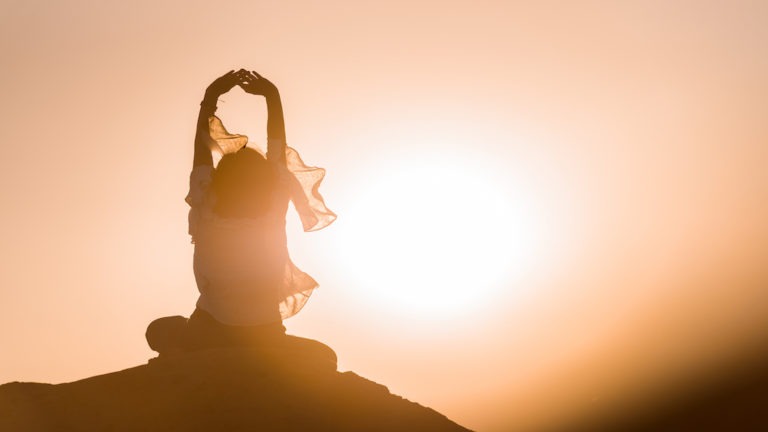
If you’ve ever stared into the backs of your eyelids and breathed white light into your navel, you’ve done breathwork. Breathwork is a new-age term that refers to rejuvenating breathing techniques aimed at awakening the body’s life force. In many circles, breathwork is a key modality utilized to inspire peacefulness, healing, and the embodiment of the divine. Stan Grof, MD, Ph.D., a clinical psychiatrist from Czechoslovakia and one the founding forefathers of research in transpersonal psychology for non-ordinary states of consciousness and the therapeutic potential of LSD, has turned breathwork into a psychedelic, and the benefits are profound.
Dr. Grof says his “holotropic” technique, i.e., turning or directing inwardly or healing toward wholeness, helps practitioners expand their consciousness through rapid, repetitive breathing.
Naysayers regard this activity as potentially dangerous, noting that it resembles hyperventilation. Regardless, thousands of people throughout the world claim Grof’s technique has reduced their stress- and mind-related ailments, and helps them access the inner wisdom of their bodies and core Self.
“Meditation is to understand that one breath connects all beings.”
― Amit Ray


